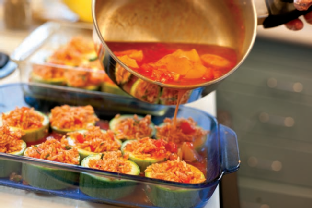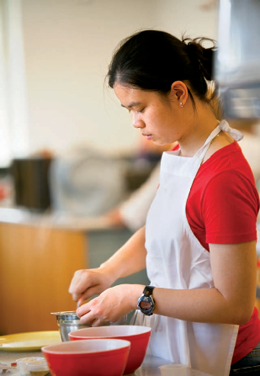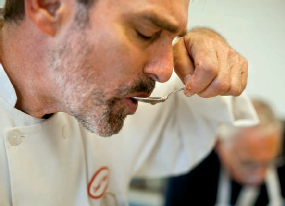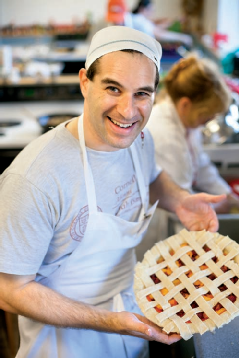
Jason Koski / University Photography
If this cooking thing doesn’t work out, Dave D’Aprix might have a promising future as an air traffic controller. Or maybe a professional juggler.
On a Tuesday in late July, D’Aprix is running around (more or less literally) and putting out fires (more or less figuratively) in the teaching kitchen of Human Ecology’s Martha Van Rensselaer Hall. The longtime Cornell chef pinballs among the nine cooking stations where seventeen CAU students are hard at work over cutting boards, mixing bowls, and stovetops. Over the next two hours, D’Aprix’s charges will concoct a cornucopia of dishes incorporating produce procured that very morning during an outing to Ithaca’s downtown farmers’ market.
In one corner, David Levine ’78 is doing honorable battle with a bowl of cold, hard butter destined for the crust of some fruit tarts; on the other side of the room, two women are strategizing an ambitious menu of roasted kale chips, baby artichokes, and blueberry-coated duck breasts; in between, their classmates are whipping up such delectables as peach-raspberry pie, seafood stew, stuffed zucchini, glazed scallops, two kinds of salmon, at least four versions of stir fry, salads galore, and wafer-thin sugar cookies with homemade raspberry sauce. It’s an atmosphere of controlled culinary chaos—and that’s before a pepper sauce accidentally becomes an aerosolized weapon. “It’s a lot of work on Tuesdays,” D’Aprix muses. “It’s just brutal, because I have twenty people going, ‘Dave! Dave! Dave!'”
Welcome to the Harried Gourmet, a popular Cornell’s Adult University course that trains amateur chefs in the art of gustatory improvisation. D’Aprix, a graduate of the Culinary Institute of America who has worked at Cornell on and off since he was hired to teach cafeteria management at the Hotel school in 1980, designed the weeklong course to focus on flexible cooking methods and dishes that could be made in an hour or less. “I think it came to me in one of my hallucinatory dreams,” he says. “I might have been thinking a little bit of Rachael Ray, whose show I’ve seen twice—the idea that people are in a hurry, so how do you make good food fast?”
D’Aprix clearly hit a nerve; the course, scheduled for the first CAU session of the summer, sold out in three days. “Harried Gourmet filled in a nanosecond,” says CAU director Catherine Sutton Penner ’68. “It even beat out golf, which usually fills up first.” Its popularity prompted CAU to convert D’Aprix’s other course (a more general cooking class scheduled for week three) into another iteration of Harried Gourmet; days after the change was announced in an e-mail blast, the second class sold out too. “The structure was a hit,” says Penner. “I think one of the appeals is the idea that someone could put together a meal for family and friends with a relatively limited number of ingredients.” It’s a tradition of CAU cooking classes that after the students consume the fruits of their labors, any leftovers are set out in the program’s lounge, free to all comers; during Harried Gourmet, Penner and her staff made sure to happen by at gustatorially advantageous moments. “They did a wonderful lamb,” she recalls, “and a pasta with clam sauce, and the breads were fantastic.”
If the Harried Gourmet has an underlying philosophy, it’s this: don’t be afraid to wing it. In addition to giving basic lessons in areas like knife skills, kitchen safety, and menu planning, D’Aprix wants his students to understand the fundamental concepts of cooking, so they’re not wedded to recipes and can whip up tasty, nutritious meals from whatever they happen to have in the fridge or larder. “The course was just amazing,” says Jonathan Bender ’00, who enrolled at the last minute after his mother, physician Carol Bender ’65, had to drop out due to work demands. “It took my technique to a whole different level.”
Bender, a former software engineer now earning a master’s degree in choral conducting at Central Michigan University, has long been interested in cuisine; as an undergrad, he was lucky enough to get a spot in the Hotel school’s ever-popular cooking course for non-majors. “In that class, everything was very specific, and we followed the recipes closely; if it said two and a half tablespoons, you had to put in two and a half tablespoons,” Bender says. “In Harried Gourmet, the concept is, ‘This is how you know when it’s done, this is how you can add this particular flavor.’ It was more about the flexibility of cooking.” Bender— whose favorite Harried Gourmet dish was lamb chops in a sauce of anchovies, capers, and sage—cites the time he put a loaf of braided French bread into the oven. “I asked Dave when I should take it out,” Bender recalls, “and he said, ‘When it’s done.'”
Seared Lamb Chops with Anchovies, Capers, and Sage
(Serves four)
15 fresh sage leaves
red pepper flakes to taste
2 tsp. minced garlic
salt and pepper to taste
3 tbs. good olive oil
3 anchovy fillets
- Season chops with salt and pepper, at least a few minutes before cooking, up to a day.
- Heat the oil in a pan large enough to hold them all in one layer.
- Add the anchovies and capers and cook until the anchovies break down, 2 to 3 minutes.
- Add the chops and let brown, about three minutes. Turn chops, add sage and red pepper. Cook until lamb is at desired doneness, 2 to 3 minutes for medium/medium rare.
- Remove chops, add garlic, cook for about a minute, spoon sauce over chops.
As D’Aprix notes, on most days Harried Gourmet is a fairly orderly enterprise. He does demonstrations in the mornings—on, say, how to properly sear a lamb chop, cook an omelet, make a Thai curry sauce, or bake a chocolate lava cake—and then students pair off to make their own versions of the dishes, which are unveiled to the group on a groaning countertop before being consumed in a communal feast. But the Tuesday farmers’ market outings make for an atmosphere of good-natured mania, in which D’Aprix helps the amateur chefs cook up whatever the market’s bounty has inspired them to create. For the outing during the second Harried Gourmet session in late July, the haul includes an entire flat of raspberries—the last of the season, D’Aprix notes as he makes a beeline for the vendor’s stall—as well as three dozen ears of corn and a dizzying assortment of peaches, kale, artichokes, fennel, sprouts, blueberries, yellow and red plums, cucumbers, beets, chard, zucchini, yellow squash, onions, cabbage, yellow and orange carrots, heirloom tomatoes, and more. Says D’Aprix as he takes his charges past one vendor’s bountiful, multi-hued table: “This looks like the cover of Saveur magazine.”
The student shoppers also pick up assorted baked treats for immediate consumption (“second breakfast,” a Hobbit tradition from one of the Lord of the Rings movies, is mentioned), as well as breads to go with lunch. Some stalls—such as the table bearing multiple varieties of garlic—inspire surprise and wonder. “I’m getting chills,” someone pipes up, “just looking at those cucumbers.” But a few steps down the row of vendors, another vegetable evokes a decidedly less worshipful reaction. “Why don’t we get some dandelion greens?” D’Aprix suggests. Pamela Davis Wells ’92, a freelance video producer from outside Syracuse, offers a reply worthy of a toddler: “Because they’re yucky.”

Jason Koski / University Photography
After a bus ride back up the hill, the students pair off to fill nine stations in the large MVR teaching kitchen. (Although there are eighteen people enrolled in the course, one is absent today, leaving Bender without a partner for his lattice-topped fruit pie.) Scrupulously clean, the room is jammed with bottles and jars of ingredients; the shelves are laden with cookbooks, from Mark Bittman’s How to Cook Everything to Joy of Cooking to titles by the Moosewood Collective, Julia Child, even Betty Crocker. “My mother hated to cook,” recalls D’Aprix, an Upstate New York native who earned a bachelor’s degree in languages from Union College before going to culinary school. “I think that’s part of the reason why my siblings and I can all cook. The year after I finished kindergarten, my brother was a baby and it became clear that my mother wasn’t going to be fixing us breakfast—so I learned to make oatmeal. I was always fascinated with food. When I was in Boy Scouts, the first merit badge I got was for cooking.”

Jason Koski / University Photography
D’Aprix joined the CAU faculty in 2010 as a last-minute replacement for longtime instructor Shelley Gould ’73, who was battling lymphoma. (Gould, whose father, Sam, founded the eponymous Collegetown store that sold University-themed merchandise to generations of Cornellians, passed away that November.) In addition to his CAU gig—which Penner hopes will continue in 2012—D’Aprix is a fraternity chef at Phi Kappa Psi and Alpha Epsilon Pi. He’s also a former Cornell student; during his days on the Hotel faculty, he began (but didn’t complete) a master’s in hotel administration through the employee degree program. “I think food is inherently interesting for most people; we have to eat,” he says. “I like interacting with students, seeing people get excited about learning. They’ve made comments like, ‘You liberated me from recipes.’ That feels good, because the biggest problem is that people get hung up on recipes and don’t understand cooking techniques. When I’m doing a demo people ask, ‘How long does that take?’ and I say, ‘I don’t know, why don’t you time it? But don’t count on it, because if your oven’s different, or you’re doing a different quantity, it’s gonna be different.'”
In the second Harried Gourmet course of the summer, D’Aprix’s students range from culinary veterans (such as Sue Thau, a former psychiatric social worker turned professional kosher caterer, who enrolled with her husband and son, Arthur and Matthew Miller) to those just starting out. Kristen Lau ’10, a master’s student in medical physics at Penn, took the course with her mom, Rosemary Mok; the whole Toronto-based family was on campus, with sister Janice Lau ’13 taking summer classes and their dad in a CAU course on the psychology of emotion. Levine, vice president of research and development for a Pittsburgh-based software company, enrolled in Harried Gourmet with an eye toward broadening his knowledge of vegetarian cookery, since his family is heading toward a meatless lifestyle. “I’ve certainly gained more confidence in the kitchen and learned a significant amount about menu planning, especially on short notice—basically opening the cabinets and the refrigerator, seeing what’s there, and coming up with a menu that makes best use of what you’ve got and who you’re cooking for,” Levine says. “The other thing I’ve gained is more confidence to either stray from recipes or not use them at all. Dave is a master at improvising; I learned a lot from him and enjoyed watching him do what he does.”
Levine particularly liked—and plans to reproduce—the method D’Aprix taught for cooking arctic char. “You place the fish on a bed of cherry tomatoes and slide it under the broiler, and the tomatoes lift the fish off the pan so it doesn’t burn,” he explains. “They keep the underside moist, while the broiler adds crispiness. Dave added potatoes to it, so we had a complete meal that was quick and easy.” The course also satisfied Levine’s long-held desire to master crispy oven-baked tofu. The secret, he learned, is pressing the water out of it, tossing it with olive oil, and cooking it at high heat. “Often, things don’t turn out as the cook expects, but that doesn’t mean that they’re awful,” Levine muses. “This is something Dave conveys, that you have to do the best with what you have. A lot of recipes are created this way; so-called mistakes turn out to be wonderful.”
Today, Levine’s projects include a savory and a sweet: he’s making oven-roasted potatoes with rosemary and some fresh fruit tarts. For the crusts, he’s attacking the butter with a hand-crank mixer. “It’s not going too well,” he admits, “but the electric mixer goes way too fast even on the slowest speed. I’m going to look for something to mash with by hand. A potato masher would be perfect.” He buttonholes D’Aprix, who tells him the desired gadget can be found in a drawer at his station. Levine starts mashing, while D’Aprix moves on to the next request. Mok needs fresh ginger for her stir fry, but there’s none to be found. “Somebody took it,” he laments, recommending that she use powdered instead. A beet issue arises; for a salad, Wells asks, should they be raw or cooked? (Cooked, either boiled or roasted.) Rachel Salpeter-Levy, an Israeli-born agronomist living in Puerto Rico, asks for advice on the raspberry sauce for her sugar cookies. “You could just cook them down and push them through a sieve and you’d have a puree and it would be beautiful,” he says. “Take four pints.”
Basic Thai Curry Sauce
(Makes two cups)
2 tbs. fish sauce
2 tbs. sugar
Pinch ground turmeric
1 shallot, minced
1 garlic clove, minced
1 tbs. curry paste (red, green, or yellow)
1 c. unsweetened coconut milk
- Heat the oil in a small saucepan over moderate heat. Add the shallot, garlic, and curry paste and allow to sizzle for 15 to 20 seconds.
- Stir in about 3 tbs. of the coconut milk. Allow to bubble for 1 minute, then add the remaining coconut milk and other ingredients.
- Simmer for 5 minutes. If you want a thicker sauce, tighten with corn starch and water.
A few countertops away, Maryland-based defense contractor Howard Kessler, Bender’s stepfather, gets lessons in deveining shrimp for his seafood stew. Then D’Aprix tells a still-skeptical Wells how to cook her dandelion greens with olive oil and garlic. “Put a little salt in to start, but very little, because they shrink down. Let them cook a little bit, gently, and then let’s taste them and see what we’ve got to do. You might have to braise them a little bit, but they look really tender. And if they’re bitter, we can use a little vinegar.” (Despite D’Aprix’s efforts, Wells later admits that the greens didn’t win her over. Her classmates didn’t seem overly fond of them either—unlike other dishes, there were plenty of leftovers—though her salmon with chipotle remoulade was a hit. “I won’t lie,” she says with a laugh. “They were still kind of bitter.”)
In addition to her sugar cookies, Salpeter-Levy is making squash stuffed with rice and tomatoes. D’Aprix asks her where she found the garlic press she’s using, then riffs on the gadget’s relative merits. “You know what I do, what I think is easier, is chop it up in a Cuisinart and put it in oil and keep it in the fridge,” he says. “It lasts forever.” A small knob of fresh ginger is unearthed, but the center turns out to have a suspiciously bluish-green hue, and D’Aprix decides to toss it. “I’ve gotta teach them mise en place,” he muses, mentioning the culinary term for organizing the ingredients before making a dish. “I haven’t told them that yet.”

Jason Koski / University Photography
Mok cuts a finger while washing her knife; it’s not bad, but D’Aprix offers a glove in case she works with something acidic. Someone wants to know where to put the extra bunches of basil. “Put them in water,” he says, “like a flower bouquet.” Matthew Miller, about to start his freshman year at Boston University, announces that instead of grilling his salmon, he plans to marinate it in a sauce of crushed raspberries, olive oil, and Dijon mustard, then sauté it. Across the room, his father, dentist Arthur Miller, is making a salad; he notes that since he’s working as an assistant to his wife, it makes him “the Sue chef.”
Over at Kessler’s station, fresh fennel is going into his seafood concoction. “It’s not real bouillabaisse,” D’Aprix notes. “Real Mediterranean bouillabaisse has no shellfish; it’s made with five types of fish. Whenever I make it I call it ‘Mediterranean-style seafood stew.’ As soon as you don’t call it something, you don’t have to follow any conventions.” Whole fennel seeds go into the pot, along with garlic, onions, scallops, shrimp, and lobster tail. D’Aprix retrieves a bottle of sauvignon blanc. “I always cook with wine,” he deadpans, “and sometimes there’s enough to put in the food.” He breaks into a Julia Child impression: “Oh Jacques,” he caterwauls, “it’s about time for a glass of wine!” Then, in his normal voice: “I met her a long time ago. She was such a nice person.”

Jason Koski / University Photography
Back over the steaming pot, he advises Kessler to add some fish broth. “I’ll show you a trick I learned out of desperation,” he says, dribbling bottled fish sauce, a staple of Thai and Vietnamese cooking, into a bowl of water. “It can be overpowering, so just a few drops.” They add saffron and some canned crushed tomatoes. “Ooh, that’s going to be good,” D’Aprix says. “It needs salt, more wine, pepper, and you know what else? A little squeeze of lemon, because it needs acid.”

Jason Koski / University Photography
As D’Aprix contemplates Kessler’s stew, a steady stream of students taps him for advice. Should scallops be seasoned before sautéing? (Yes, with salt and pepper.) How long it will take to oven-roast potatoes? (Thirty to forty minutes.) What sauce might be good on steamed baby artichokes? (A vinaigrette dressing, since there’s no time to make hollandaise.) “Anybody looking for something to do?” D’Aprix asks. “Anybody bored? You want to grill those squashes? It’s hard for me to walk the room and grill.” Then: “Who’s got the zester? Can we borrow it?” Some lemon zest goes into the seafood stew, and D’Aprix advises Salpeter-Levy on thickening her raspberry sauce with cornstarch after straining it. “That’s why the French have apprentices,” he says. “So they can stand there for an hour and do it.”
Molten Chocolate Cakes
(Serves six)
1/4 tsp. kosher salt
3 eggs 1/4 c. flour, plus more for dusting
confectioners’ sugar
1 tbs. dark rum
3 tbs. heavy cream
8 tbs. butter, plus more for greasing
6 oz. bittersweet chocolate
1/2 c. sugar
- Put semisweet chocolate and rum in a small bowl. Heat cream in a small saucepan just to the boil, pour over chocolate, and let sit for 1 minute. Sir until smooth, cover, and refrigerate until chilled. Divide into 6 portions, shape into balls, and keep chilled.
- Heat oven to 425 F.
- Grease bottoms and sides of six 6-oz. ramekins with butter and dust with flour; set aside on a sheet pan.
- Heat butter and bittersweet chocolate in a small saucepan over medium heat until just melted. Remove from heat and let cool 10 minutes.
- In a large bowl, beat together sugar, vanilla, salt, and eggs with a hand mixer on medium-high speed until thick and pale, 3 to 4 minutes. Beat in melted chocolate mixture; add flour and mix until smooth.
- Divide half the batter between ramekins and place a chilled chocolate ball in center of each; top with remaining batter and smooth tops. Bake until just set, about 15 minutes. Let cool 2 to 3 minutes.
- To serve, run a paring knife around edge of ramekins and invert cakes onto 6 serving plates. Dust with confectioners’ sugar and serve immediately.
Suddenly the room erupts in coughing and choking, as every breath brings a lungful of abrasive, peppery air. Lau and her partner are making a maple-chipotle glaze for their pan-seared scallops with julienned carrots, squash, and onions; per D’Aprix’s instructions, they’ve boiled a cup of maple syrup with some juice from a can of chipotle peppers, and now everyone is gasping for breath— though the class seems more amused than alarmed, and nobody stops working. “When you heat up the pepper sauce it gets into people’s lungs,” D’Aprix observes. “That’s OK. It’s not toxic or anything.”
Returning to the stewpot, D’Aprix decides that it’s missing something, and adds some red wine vinegar. “It doesn’t have enough acid,” he says. “These canned tomatoes are really sweet. The wine we’re using isn’t acidic, and I guess we drank more than we put in. If we’d used a pinot grigio it probably would have been all right.” He samples it again. “It still tastes flat. Do we have enough salt in there? Yeah, it needs more.” Another taste, then the addition of a half-teaspoon of red pepper. “It’s very strong—you don’t want to kill people—and it’s not traditional,” he says. Before going in search of a knife to slice the duck breasts, he makes another pronouncement. “In France,” he says, “they’re red pepper wimps.”


